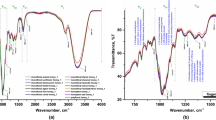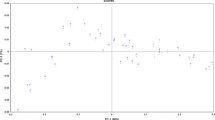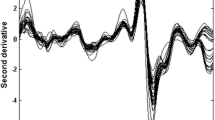Abstract
We evaluated the effects of pre-processing thermal treatments on the physicochemical, colour and near-infrared (NIR) spectral data of 30 honey samples. The trial was settled as a bi-factorial experimental design that considered nine experimental groups according to the fixed effects of heating treatment and honey phase: none, mild (39 °C for 30′) and high heating (55 °C for 24 h) per crystallised, bi-phase and liquid honey samples. Increasing temperatures significantly modified moisture, hydroxymethylfurfural content and lightness. The multivariate classifier models showed that NIR data of warmed crystallised and bi-phase honeys were significantly different from that of the untreated ones, while they sorted a similar assignment for all the liquid samples. The support vector machine model confirmed that the highest tested temperature represented a bias in the informative feature of NIR data, if they would be used in further analytical assessment of the intrinsic qualities of crystallised or bi-phase honey.




Similar content being viewed by others
References
Pita-Calvo C, Guerra-Rodríguez ME, Vázquez M (2017) Analytical methods used in the quality control of honey. J Agric Food Chem 65:690–703. https://doi.org/10.1021/acs.jafc.6b04776
Cavia MM, Fernández-Muio MA, Gömez-Alonso E, Montes-Pérez MJ, Huidobro JF, Sancho MT (2002) Evolution of fructose and glucose in honey over one year: influence of induced granulation. Food Chem 78:157–161. https://doi.org/10.1016/S0308-8146(01)00393-4
Da Silva PM, Gauche C, Gonzaga LV, Costa ACO (2016) Honey: chemical composition, stability and authenticity. Food Chem 196:309–323. https://doi.org/10.1016/j.foodchem.2015.09.051
Escuredo O, Seijo MC, Salvador J, González-Martín MI (2013) Near infrared spectroscopy for prediction of antioxidant compounds in the honey. Food Chem 141:3409–3414. https://doi.org/10.1016/j.foodchem.2013.06.066
Latorre CH, Crecente RMP, Martín SG, García JB (2013) A fast chemometric procedure based on NIR data for authentication of honey with protected geographical indication. Food Chem 141:3559–3565. https://doi.org/10.1016/j.foodchem.2013.06.022
Li S, Zhang X, Shan Y, Su D, Ma Q, Wen R, Li J (2017) Qualitative and quantitative detection of honey adulterated with high-fructose corn syrup and maltose syrup by using near-infrared spectroscopy. Food Chem 218:231–236. https://doi.org/10.1016/j.foodchem.2016.08.105
Ruoff K, Luginbühl W, Bogdanov S, Bosset JO, Estermann B, Ziolko T, Kheradmandan S, Amadò R (2007) Quantitative determination of physical and chemical measurands in honey by near-infrared spectrometry. Eur Food Res Technol 225:415–423. https://doi.org/10.1007/s00217-006-0432-8
Frausto-Reyes C, Casillas-Peñuelas R, Quintanar-Stephano JL et al (2017) Spectroscopic study of honey from Apis mellifera from different regions in Mexico. Spectrochim Acta Part A Mol Biomol Spectrosc 178:212–217. https://doi.org/10.1016/j.saa.2017.02.009
Bázár G, Romvári R, Szabó A, Somogyi T, Éles V, Tsenkova R (2016) NIR detection of honey adulteration reveals differences in water spectral pattern. Food Chem 194:873–880. https://doi.org/10.1016/j.foodchem.2015.08.092
Bakier S (2009) Capabilities of near-infrared spectroscopy to analyse changes in water bonding during honey crystallisation process. Int J Food Sci Technol 44:519–524. https://doi.org/10.1111/j.1365-2621.2008.01837.x
Escuredo O, Dobre I, Fernández-González M, Seijo MC (2014) Contribution of botanical origin and sugar composition of honeys on the crystallization phenomenon. Food Chem 149:84–90. https://doi.org/10.1016/j.foodchem.2013.10.097
Ribeiro GP, Villas-Bôas JK, Spinosa WA, Prudencio SH (2018) Influence of freezing, pasteurization and maturation on Tiúba honey quality. LWT Food Sci Technol 90:607–612. https://doi.org/10.1016/j.lwt.2017.12.072
Zhao H, Cheng N, Zhang Y, Sun Z, Wang Y, Cao W (2018) The effects of different thermal treatments on amino acid contents and chemometric-based identification of overheated honey. LWT 96:133–139. https://doi.org/10.1016/j.lwt.2018.05.004
Chen G, Huang Y, Chen K (2014) Research article recent advances and applications of near infrared spectroscopy for honey quality assessment. Adv J Food Sci Technol 6:461–467. https://doi.org/10.19026/ajfst.6.55
Bisutti V, Merlanti R, Serva L, Lucatello L, Mirisola M, Balzan S, Tenti S, Fontana F, Trevisan G, Montanucci L, Contiero B, Segato S, Capolongo F (2019) Multivariate and machine learning approaches for honey botanical origin authentication using near infrared spectroscopy. J Near Infrared Spectrosc 27(1):65–74. https://doi.org/10.1177/0967033518824765 (096703351882476)
Il Ministero delle Politiche Agricole e Forestali (2003) D.M. 25 luglio 2003 Metodi di analisi per la valutazione delle caratteristiche di composizione del miele. Gazz Uff della Repubb Ital 185:24–54
Bogdanov S (2009) Harmonised methods of the international IHC. Bee Prod Sci. https://doi.org/10.1007/s13398-014-0173-7.2
Grané A, Jach A (2014) Application of principal component analysis (PCA) in food science and technology. Wiley, Chichester
Serva L, Balzan S, Bisutti V, Montemurro F, Marchesini G, Bastianello E, Segato S, Novelli E, Fasolato L (2019) Use of near infrared spectroscopy and chemometrics to evaluate the shelf-life of cloudy sonicated apple juice. J Near Infrared Spectrosc 27:75–85. https://doi.org/10.1177/0967033518821833 (096703351882183)
Kursa MB, Rudnicki WR (2010) Feature selection with the Boruta package. J Stat Softw 36:1–13. https://doi.org/10.18637/jss.v036.i11
Guelpa A, Marini F, du Plessis A, Slabbert R, Manley M (2017) Verification of authenticity and fraud detection in South African honey using NIR spectroscopy. Food Control 73:1388–1396. https://doi.org/10.1016/j.foodcont.2016.11.002
Cano CB, Felsner ML, Matos JR, Bruns RE, Whatanabe HM, Almeida-Muradian LB (2001) Comparison of methods for determining moisture content of citrus and eucalyptus Brazilian honeys by refractometry. J Food Compos Anal 14:101–109. https://doi.org/10.1006/jfca.2000.0951
Hamdan K (2010) Crystallization of honey. Bee World 87:71–74. https://doi.org/10.1080/0005772X.2010.11417371
Singh I, Singh S (2018) Honey moisture reduction and its quality. J Food Sci Technol. https://doi.org/10.1007/s13197-018-3341-5
Andersen CM, Bro R (2010) Variable selection in regression-a tutorial. J Chemom 24:728–737. https://doi.org/10.1002/cem.1360
Leardi R (2000) Application of genetic algorithm–PLS for feature selection in spectral data sets. J Chemom 14:643–655. https://doi.org/10.1002/1099-128X(200009/12)14
Acknowledgements
This study was financially supported by the FONDAZIONE CARIVERONA (Project SAFIL, call 2016) and Padova University (Project CPDA 158894/15-PRAT).
Author information
Authors and Affiliations
Corresponding author
Ethics declarations
Conflict of interest
The authors declare no conflicts of interest exist in the submission of this manuscript.
Compliance with ethics requirements
This article does not contain any studies with human or animal subjects.
Additional information
Publisher's Note
Springer Nature remains neutral with regard to jurisdictional claims in published maps and institutional affiliations.
Rights and permissions
About this article
Cite this article
Segato, S., Merlanti, R., Bisutti, V. et al. Multivariate and machine learning models to assess the heat effects on honey physicochemical, colour and NIR data. Eur Food Res Technol 245, 2269–2278 (2019). https://doi.org/10.1007/s00217-019-03332-x
Received:
Revised:
Accepted:
Published:
Issue Date:
DOI: https://doi.org/10.1007/s00217-019-03332-x




